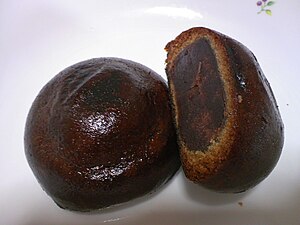Manjū: Difference between revisions
Vishnu Tags: Visual edit Mobile edit Mobile web edit |
Undid revision 902554783 by 2401:4900:35F0:198E:B546:AED:A0A:C8A (talk) |
||
| Line 3: | Line 3: | ||
{{Expand Japanese|饅頭|date=October 2012}} |
{{Expand Japanese|饅頭|date=October 2012}} |
||
{{More citations needed|date=November 2007}} |
{{More citations needed|date=November 2007}} |
||
{{Infobox prepared food |
|||
| name = Manjū |
|||
| image = Carinto manjyu.JPG |
|||
| image_size = 300px |
|||
| caption = |
|||
| alternate_name = |
|||
| country = [[Japan]] |
|||
| region = |
|||
| creator = |
|||
| course = |
|||
| type = [[Wagashi]] |
|||
| served = |
|||
| main_ingredient = [[Flour]], [[rice]] powder, [[buckwheat]], [[red bean paste]] |
|||
| variations = |
|||
| calories = |
|||
| other = |
|||
}} |
|||
{{nihongo|'''Manjū'''|饅頭||{{nihongo2|まんじゅう}}}} is a popular traditional [[wagashi|Japanese confection]]. There are many varieties of manjū, but most have an outside made from [[flour]], [[rice]] powder, [[kudzu]] and [[buckwheat]] and a filling of ''anko'' ([[red bean paste]]), usually made from boiled [[adzuki bean]]s and sugar. Manjū is sometimes made with other fillings like [[chestnut jam]]. In [[Hawaii]], one can find [[Okinawa]]n manjū that are made with a filling of purple [[sweet potato]], butter, milk, sugar and salt, but the most common filling is bean paste of which there are several varieties including ''koshian'', ''tsubuan'', and ''tsubushian''. |
{{nihongo|'''Manjū'''|饅頭||{{nihongo2|まんじゅう}}}} is a popular traditional [[wagashi|Japanese confection]]. There are many varieties of manjū, but most have an outside made from [[flour]], [[rice]] powder, [[kudzu]] and [[buckwheat]] and a filling of ''anko'' ([[red bean paste]]), usually made from boiled [[adzuki bean]]s and sugar. Manjū is sometimes made with other fillings like [[chestnut jam]]. In [[Hawaii]], one can find [[Okinawa]]n manjū that are made with a filling of purple [[sweet potato]], butter, milk, sugar and salt, but the most common filling is bean paste of which there are several varieties including ''koshian'', ''tsubuan'', and ''tsubushian''. |
||
Revision as of 01:13, 20 June 2019
It has been suggested that Usukawa Manju be merged into this article. (Discuss) Proposed since June 2019. |
You can help expand this article with text translated from the corresponding article in Japanese. (October 2012) Click [show] for important translation instructions.
|
This article needs additional citations for verification. (November 2007) |
 | |
| Type | Wagashi |
|---|---|
| Place of origin | Japan |
| Main ingredients | Flour, rice powder, buckwheat, red bean paste |
Manjū (饅頭, まんじゅう) is a popular traditional Japanese confection. There are many varieties of manjū, but most have an outside made from flour, rice powder, kudzu and buckwheat and a filling of anko (red bean paste), usually made from boiled adzuki beans and sugar. Manjū is sometimes made with other fillings like chestnut jam. In Hawaii, one can find Okinawan manjū that are made with a filling of purple sweet potato, butter, milk, sugar and salt, but the most common filling is bean paste of which there are several varieties including koshian, tsubuan, and tsubushian.
History
Manjū was derived from a type of mochi (蒸餅), or pounded rice cake, that has existed in China for a long time.[when?] It was originally called Mantou in Chinese, but became known as manjū when it came to Japan. In 1341, a Japanese envoy that came back from China brought back mantou with him and started to sell it as nara-manjū. It is said that this was the origin of Japanese manjū. Since then, it has been eaten for nearly 700 years by Japanese people. Now it can be found in many Japanese sweet shops. Its low price is a reason that it is popular.
Varieties

There are myriad varieties of manjū, some more common than others.
- Matcha (green tea) manjū is one of the most common. In this case, the outside of the manjū has a green tea flavor and is colored green.
- Mizu (water) manjū is traditionally eaten in the summertime and contains a flavored bean filling. The exterior of the mizu manjū is made with kuzu starch, which gives the dough a translucent, jelly-like appearance.[1]
- There are also manjū that have different flavored fillings, such as orange-flavored cream.
- As is the case with many Japanese foods, in some parts of Japan one can find manjū unique to that region, such as the maple leaf-shaped momiji manjū in Hiroshima and Miyajima.
- The regional variety of the Saitama prefecture is called Jumangoku Manju.
See also
![]() Media related to Manjū at Wikimedia Commons
Media related to Manjū at Wikimedia Commons
- Daifuku
- Mantou (饅頭, Chinese plain steamed bun), etymologically the origin of the word, although in modern Chinese the term for filled buns is baozi
- Manti (Turkic) and mandu (Korean), filled dumplings with the names being cognate with mantou and manjū
- Nikuman
- Tangyuan (food)
References
- ^ Schilling, Christine (2007). "Translator's Notes." in Kirishima, Takeru (2002). Kanna Volume 2. California: Go! Comi (Go! Media Entertainment, LLC). ISBN 978-1-933617-56-5
